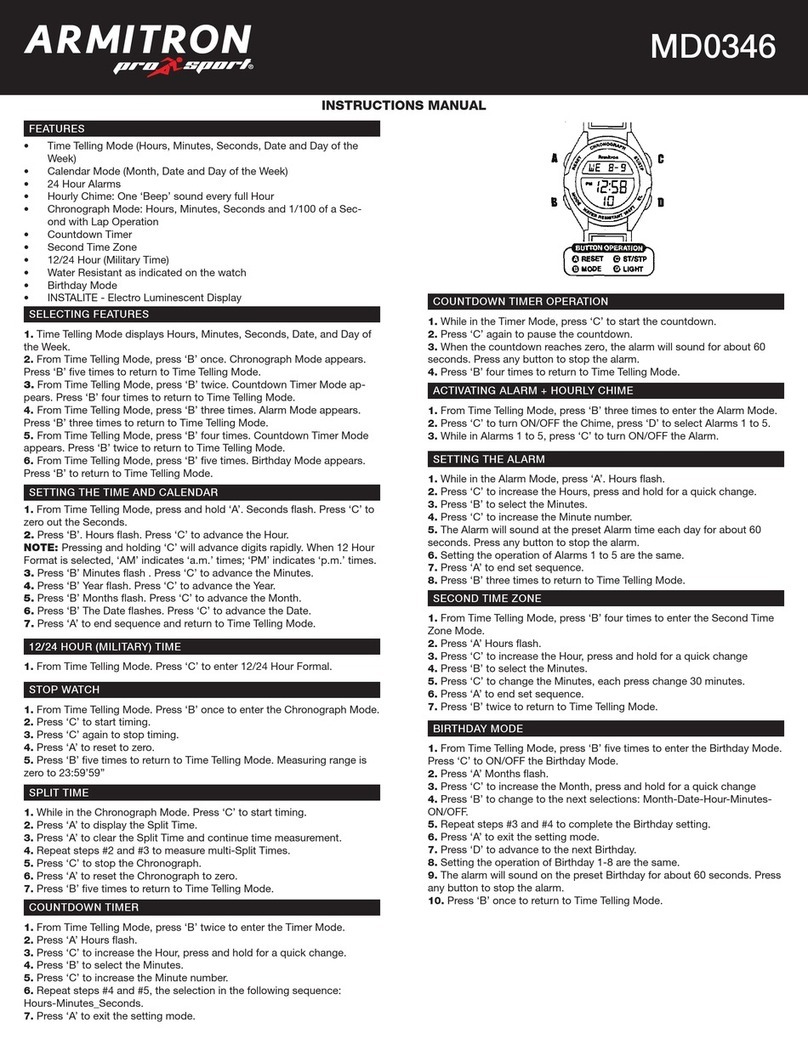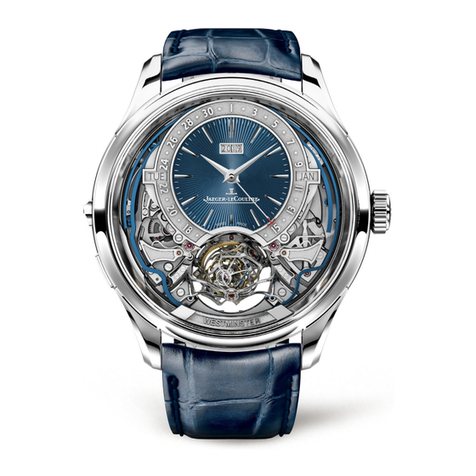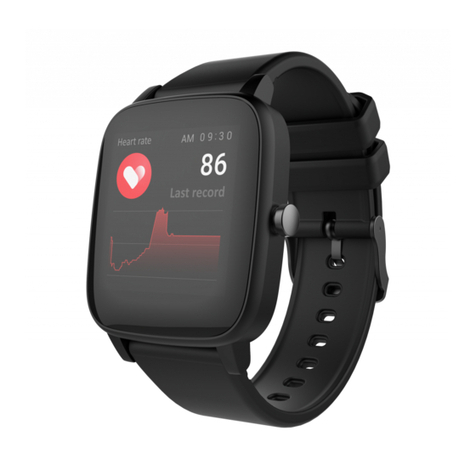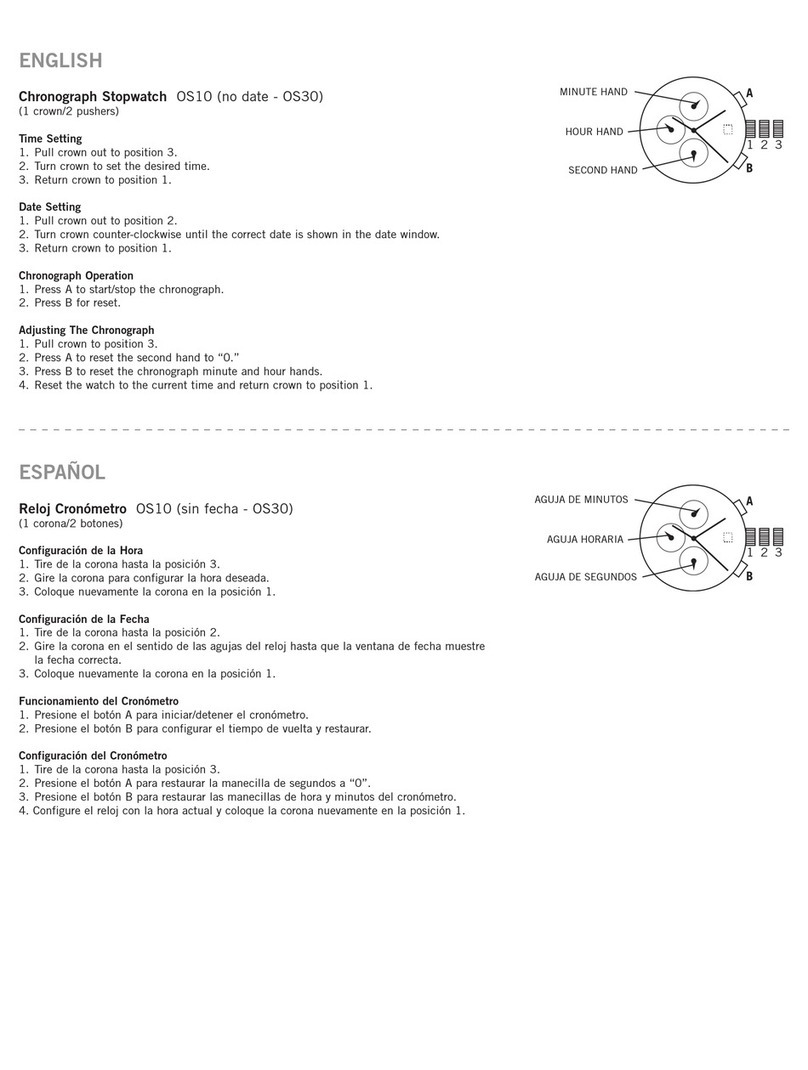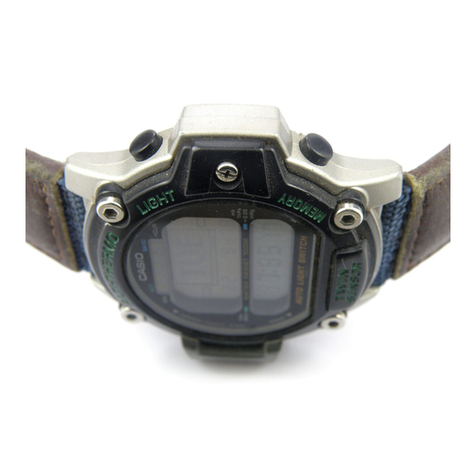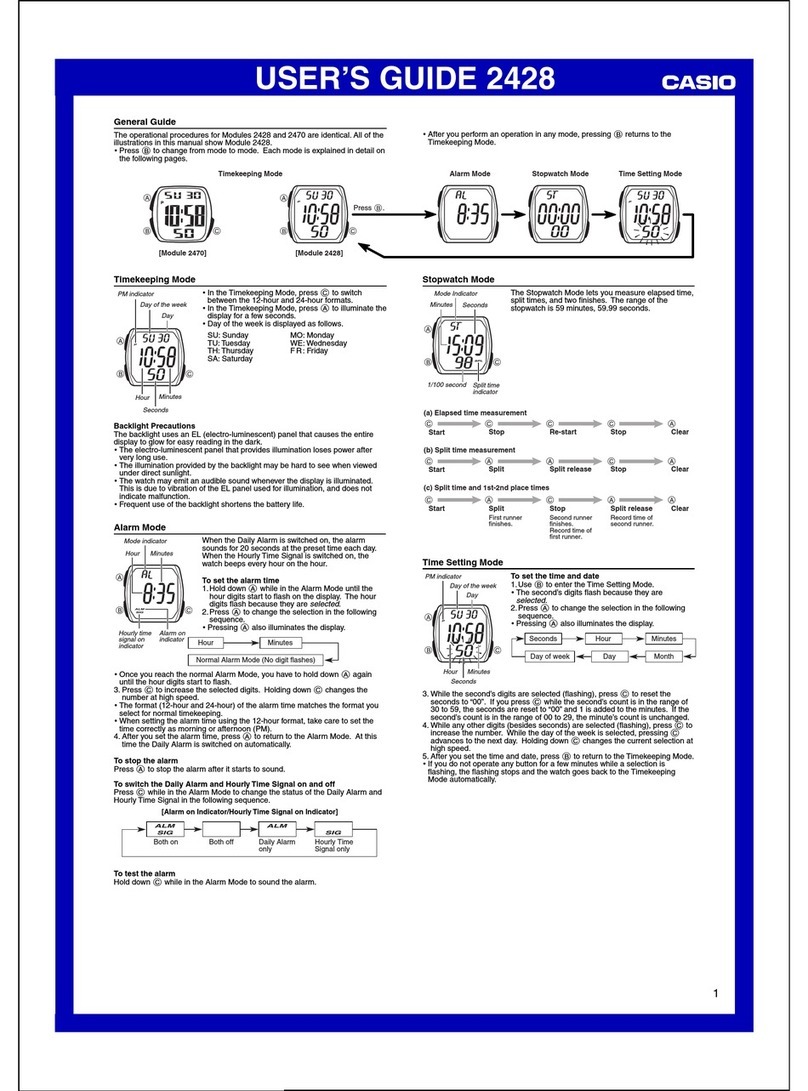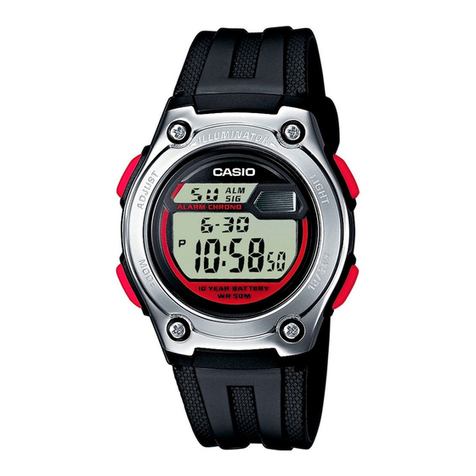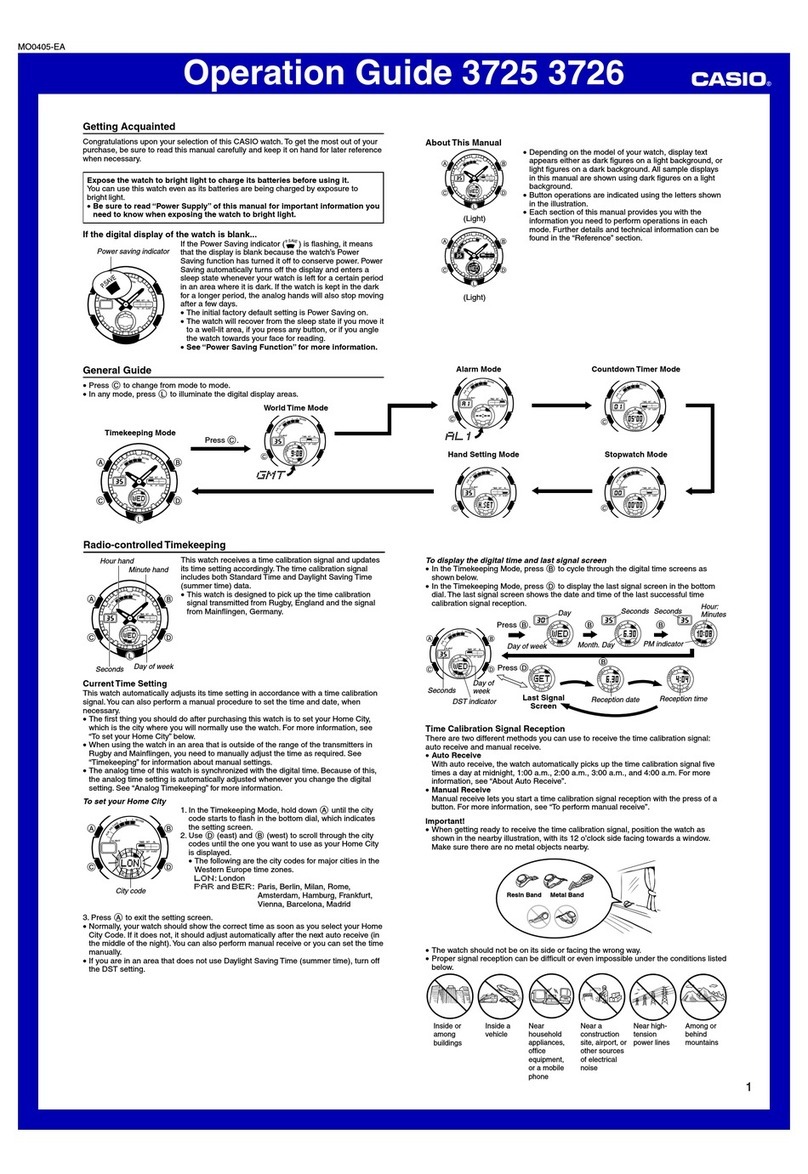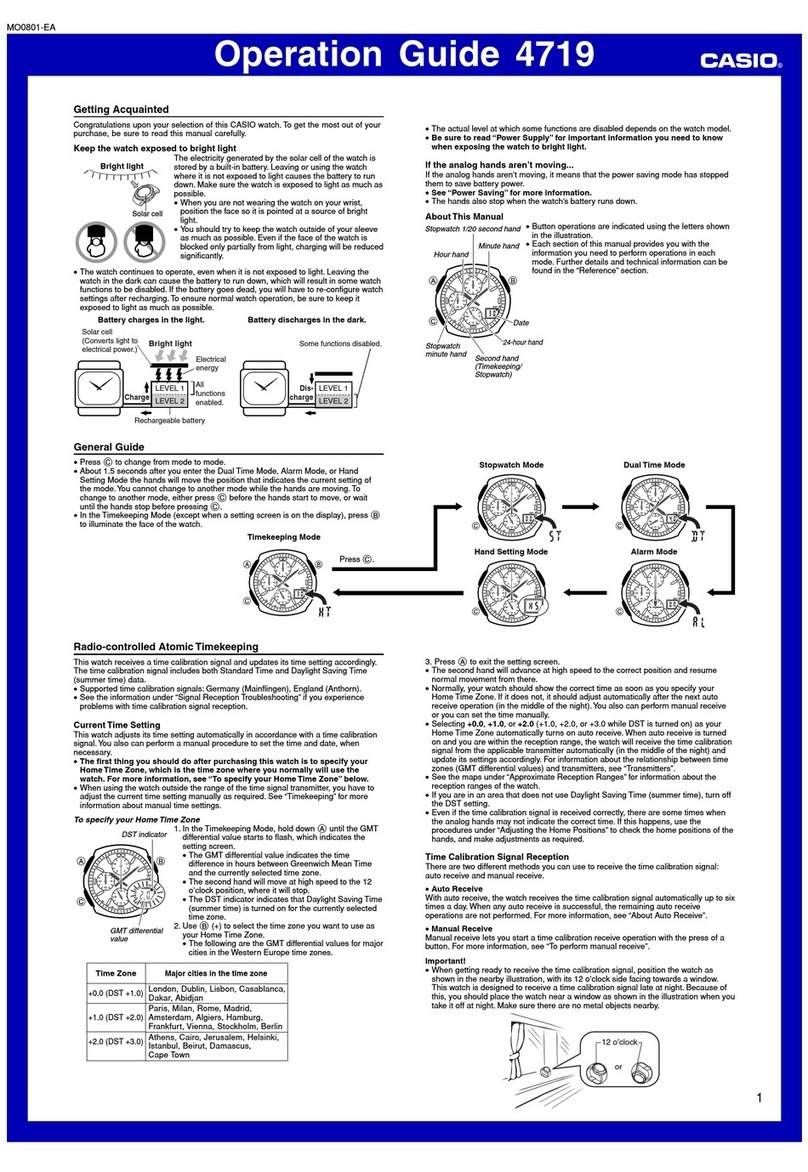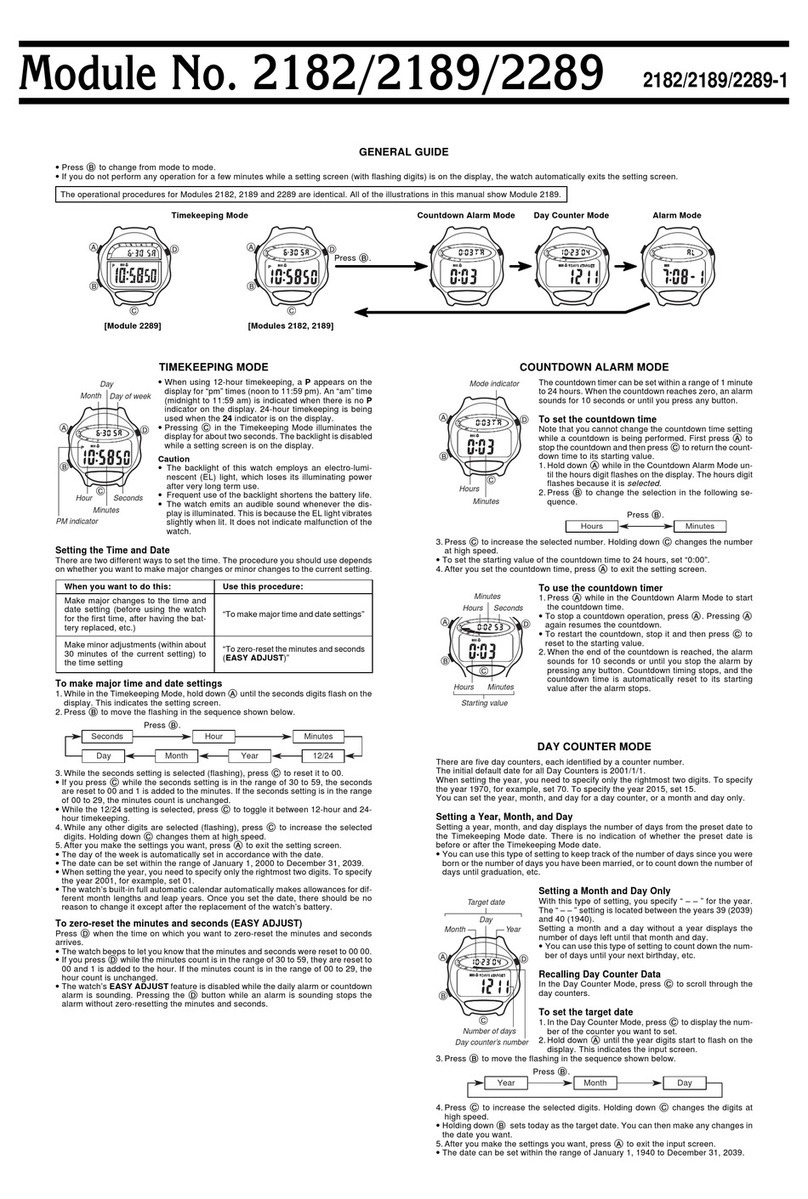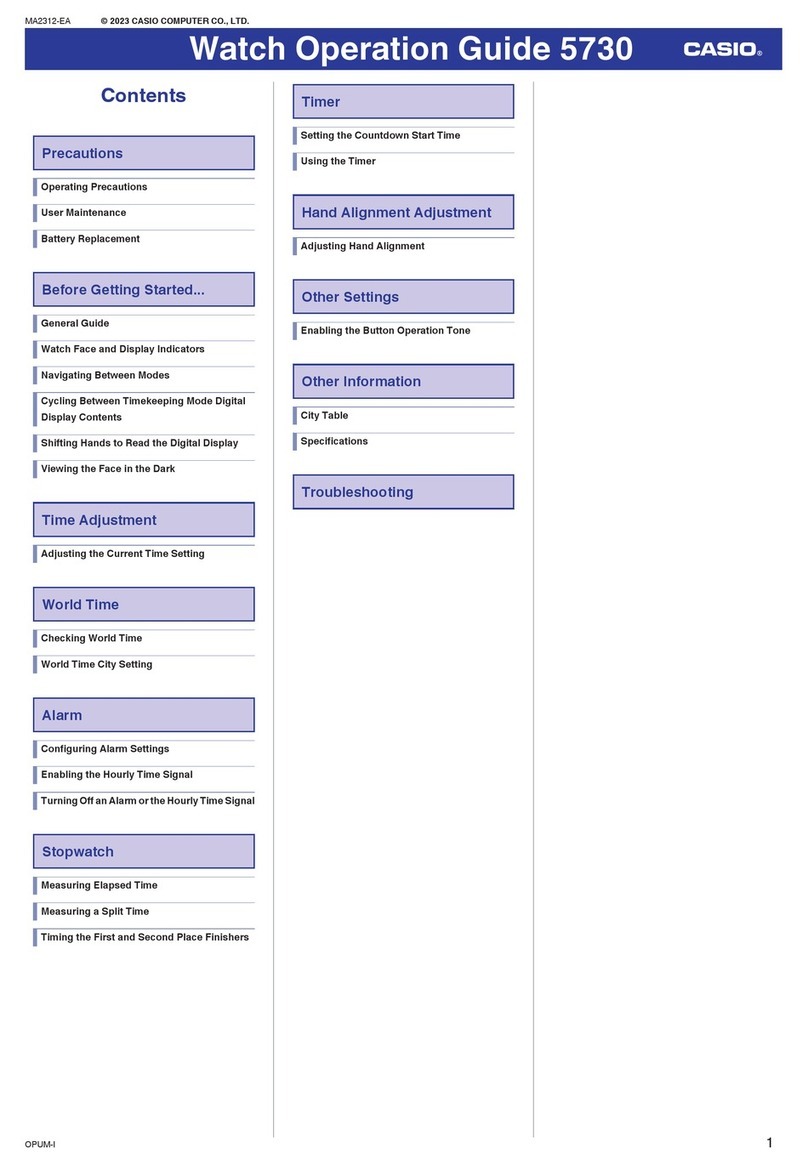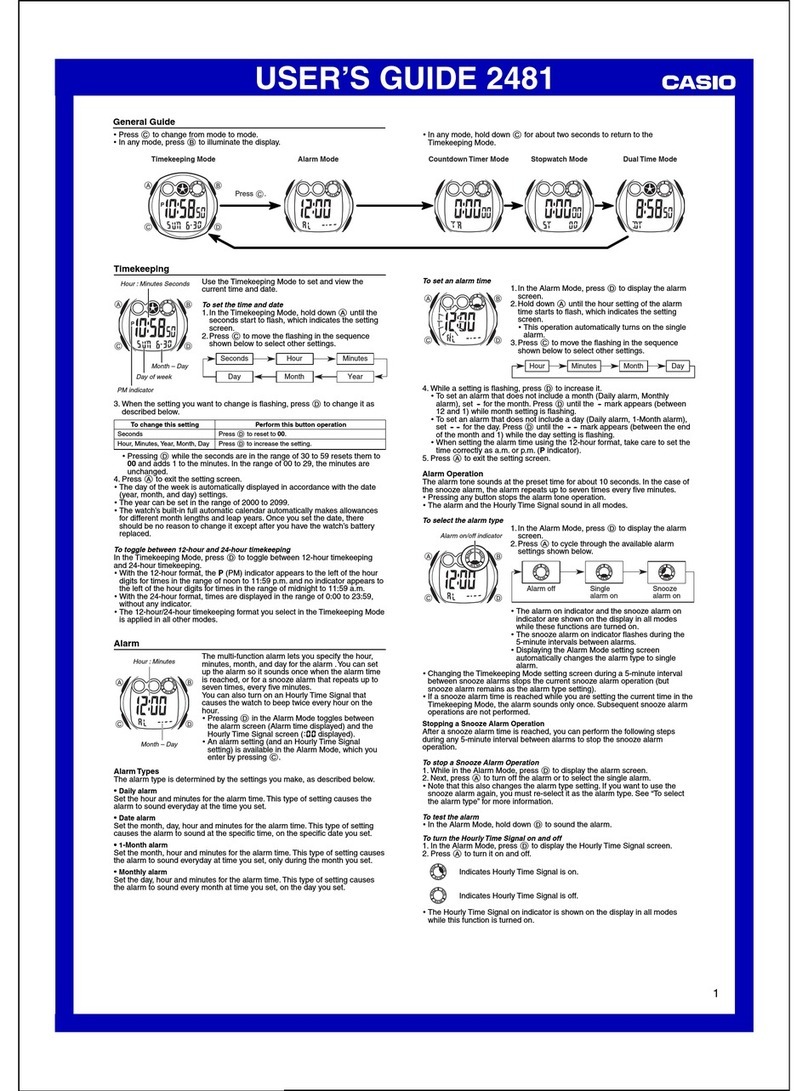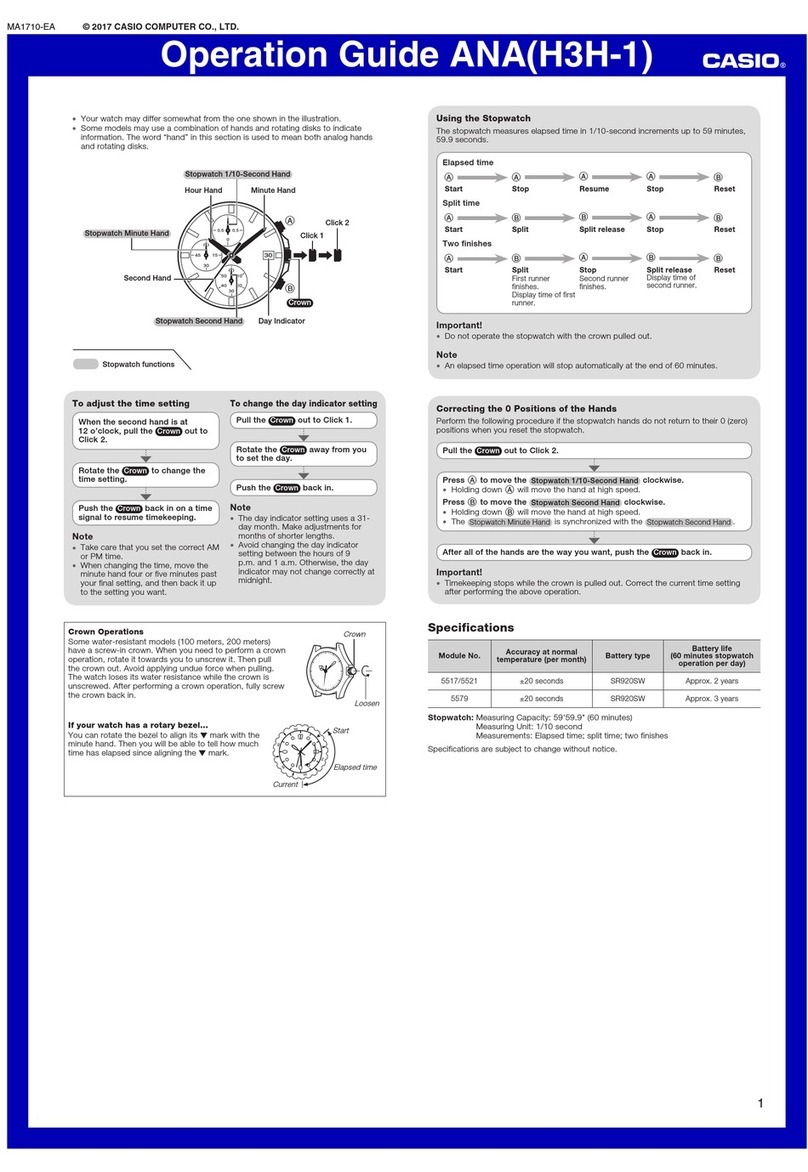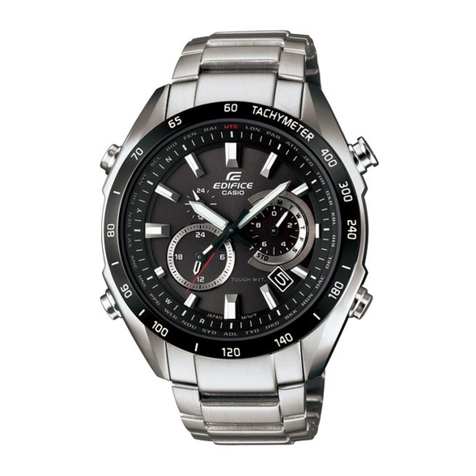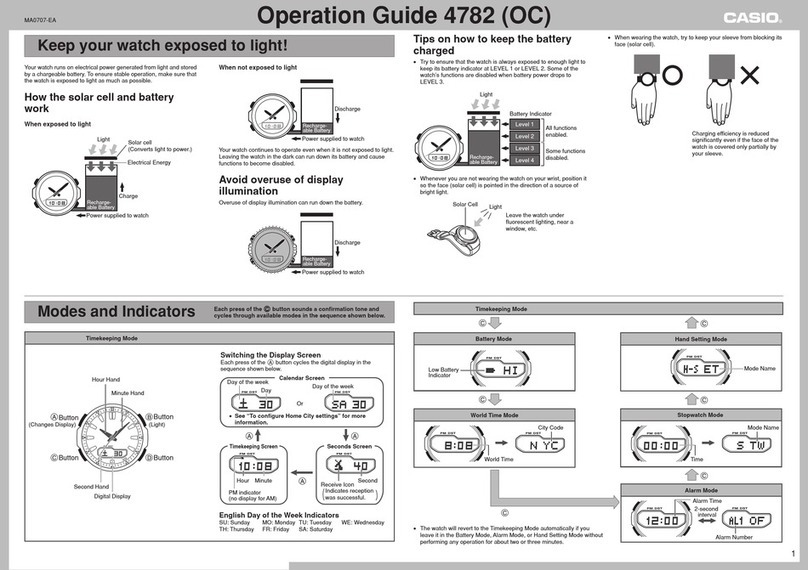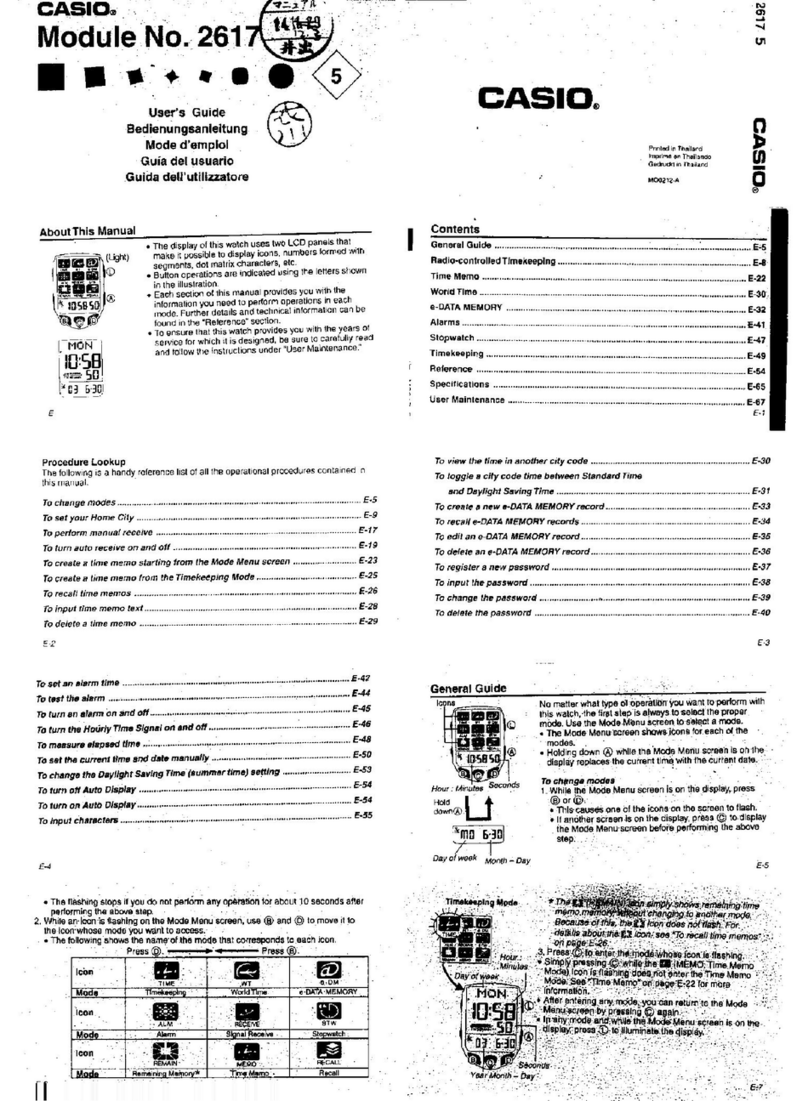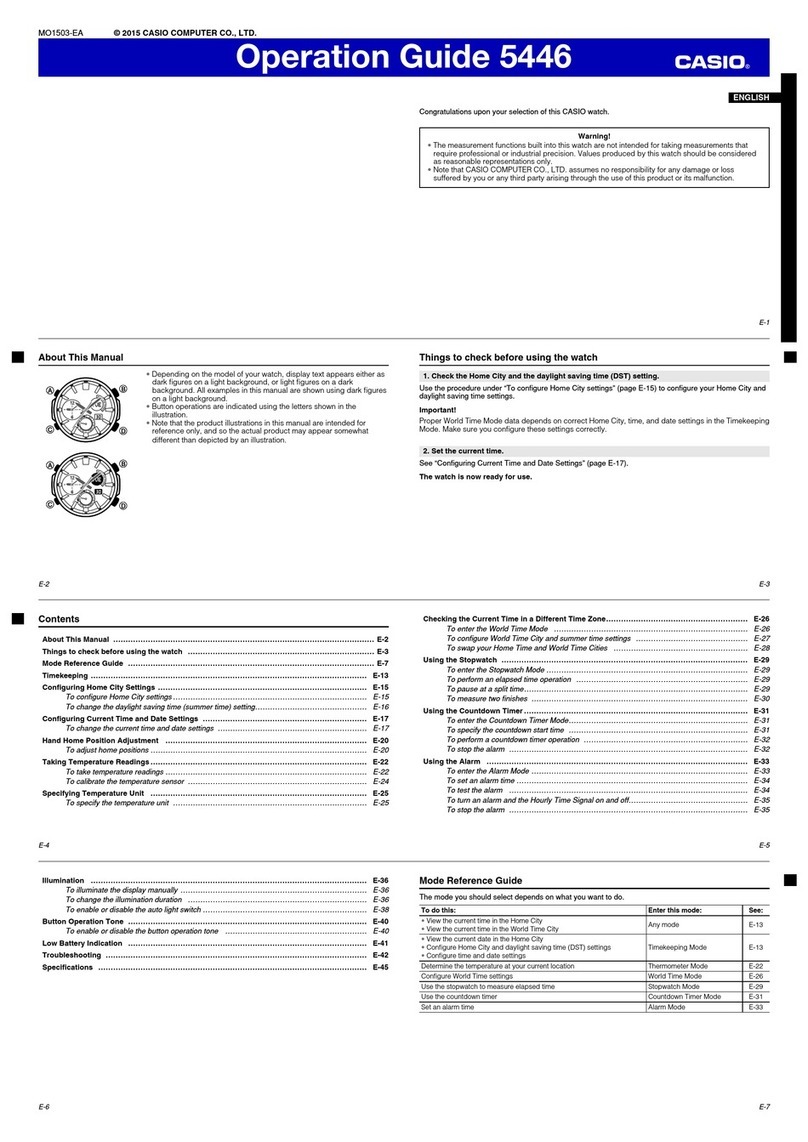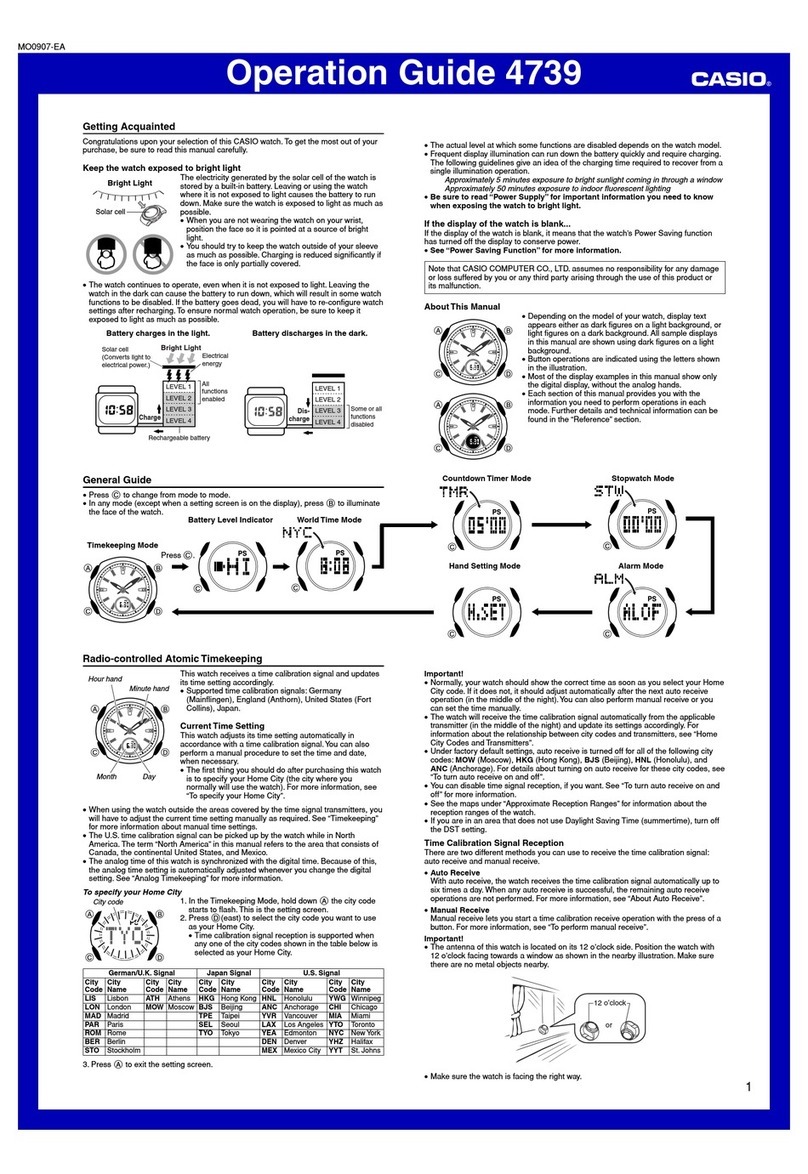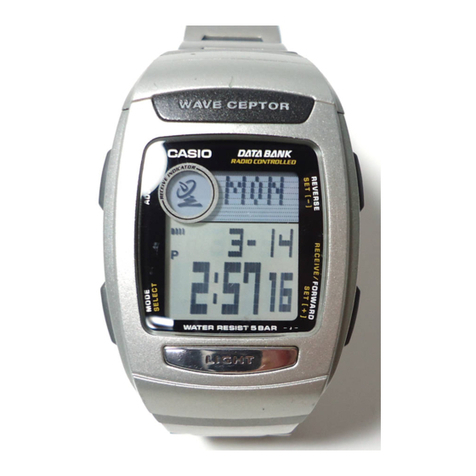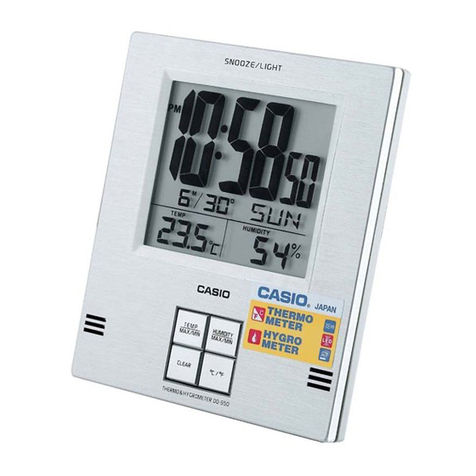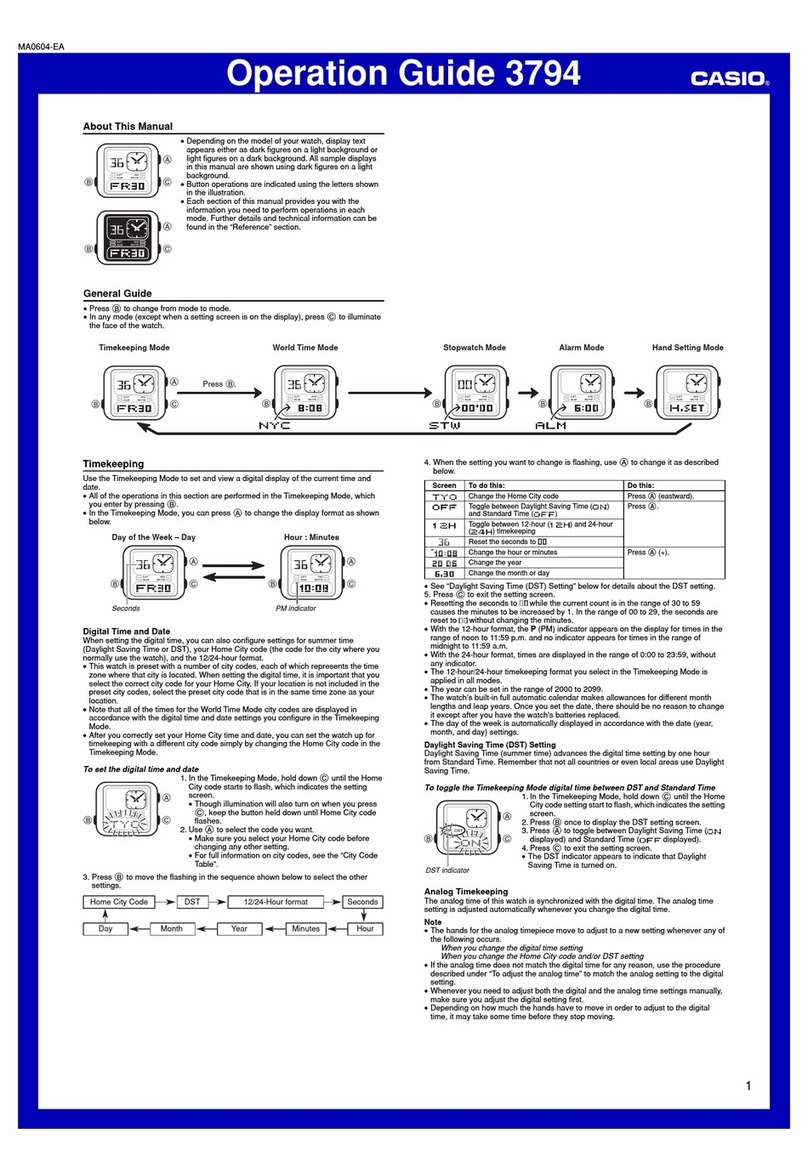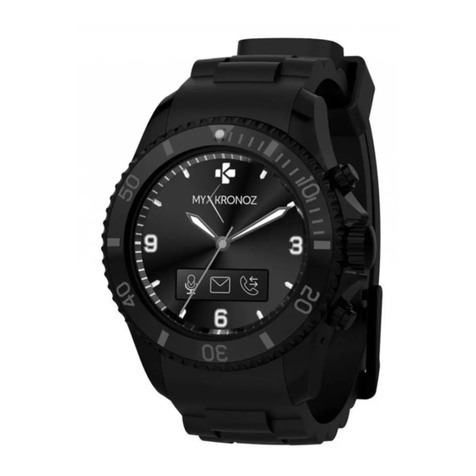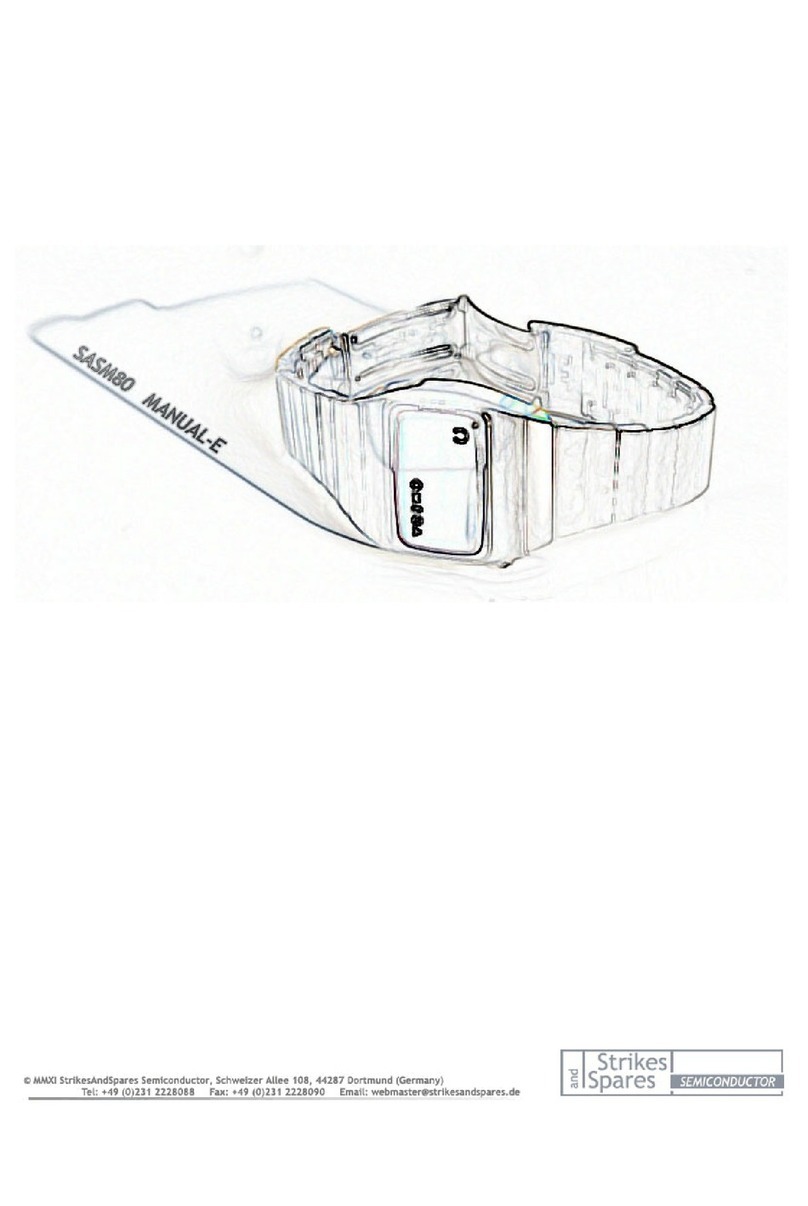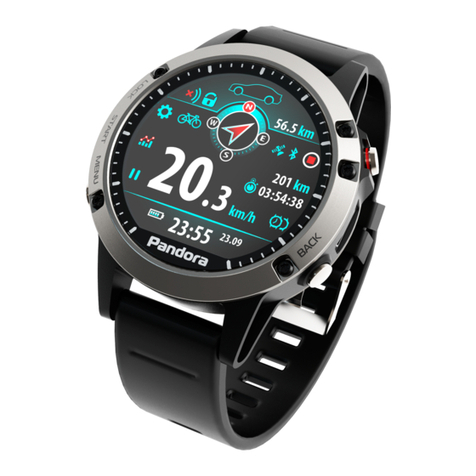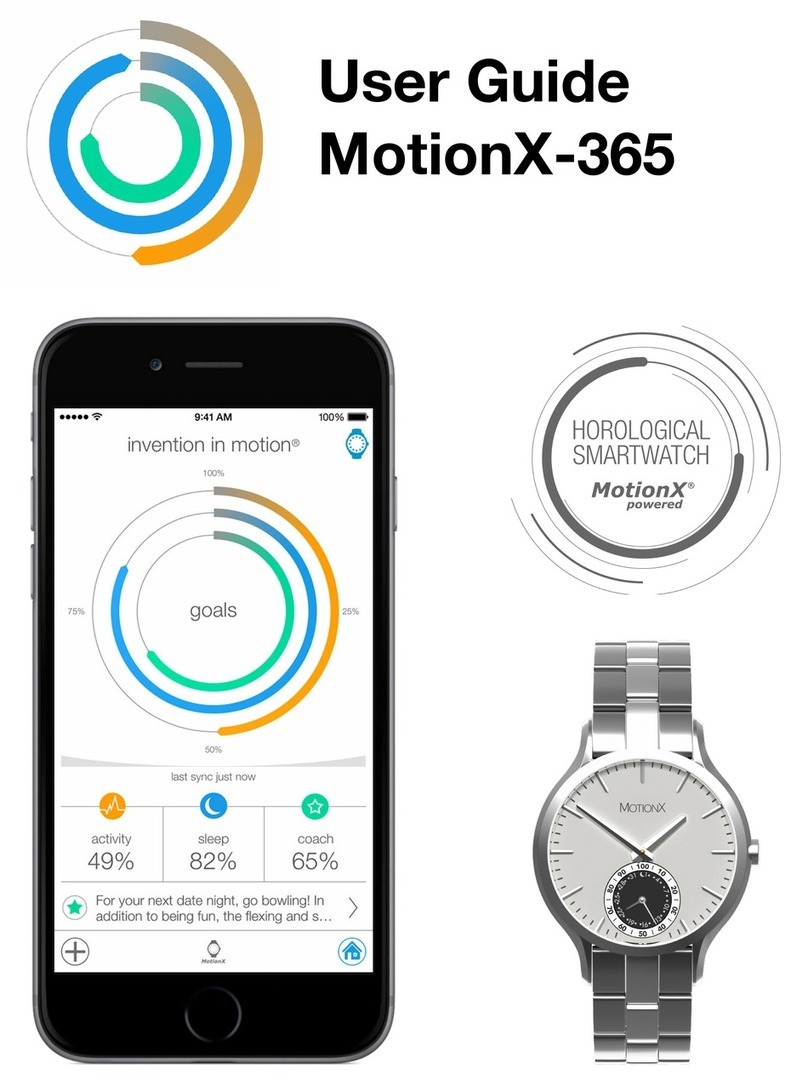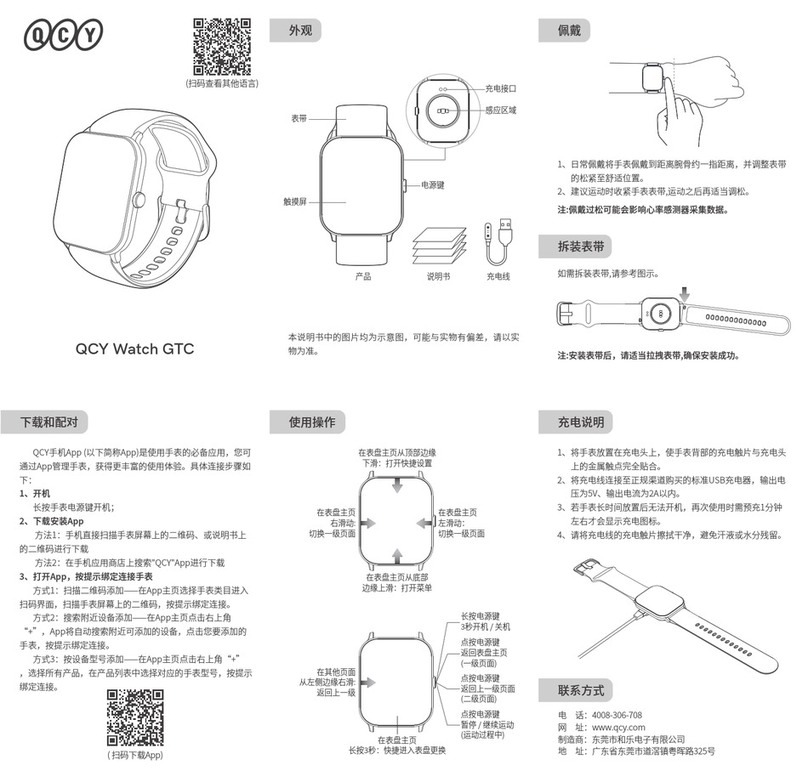
USER’S GUIDE 2513
5
Problem
Cannot perform
manual receive.
Auto receive is
turned on, but
the receive
indicator does
not appear on
the display.
Probable Cause
•
The watch is not in the Timekeeping Mode.
•You do not select one of the following
City Codes as your Home City Code:
TYO, NYC, CHI, DEN, or LAX.
•You changed the time setting manually.
•The watch was not in the Timekeeping or
World Time Mode, or you were
performing some button operation during
the auto signal receive operation was
performed.
•
Even if receive is successful, the receive
indicator disappears every day at 3am.
•Time data (hour, minutes, seconds) only
was received during the last receive
operation. The receive indicator appears
only when time data and date data
(year, month, day) are both received.
What you should do
•Enter the Timekeeping Mode
and try again.
•Select the correct Home City
Code.
•Perform manual signal receive
or wait until the next auto
signal receive operation is
performed.
•Check to make sure the watch
is in a location where it can
receive the signal.
•
Put the watch in a location
that is suitable for good
reception.
Time setting is
incorrect
following signal
reception.
•If the time is one hour off, the DST
setting may be incorrect.
•The Home City Code setting is not
correct for the area where you are using
the watch.
•Change the DST setting to
AUTO DST.
•Select the correct Home City
Code.
•When you select one of the city codes shown below as your Home City code, the
watch sets up automatically to receive from the applicable transmitter. Time
calibration signal reception is not possible whenever any other city code is specified
as the Home City code.
•When you select TYO as your Home City code, the watch automatically selects
either the Fukushima signal (40kHz) or the Fukuoka/Saga signal (60kHz),
depending on which is stronger.
•Note that when TYO (Japan) is selected as the Home City code, you can specify one
of two different time signal transmitters.
Home City Code
LAX, DEN, CHI, NYC
TYO
Received Transmitter
Fort Collins, Colorado
Fukushima or Fukuoka/Saga, Japan
(selectable)
•Signal reception is possible within a radius of about 2,000 miles (3,000 kilometers)
from the Fort Collins transmitter.
•At distances further than about 500 kilometers from the Fukushima and Fukuoka/
Saga transmitter, the signal may become weak and reception may be impossible
under certain conditions.
Fort Collins
2,000 miles
1,200 miles
1,000
kilometers
1,000
kilometers
Fukuoka/Saga
500
kilometers
Fukushima
500
kilometers
General Precautions
•The watch is designed to automatically update the date and day of the week for the
period January 1, 2000 to December 31, 2039. Setting of the date by the time
calibration signal cannot be performed starting from January 1, 2040.
•This watch can receive signals that differentiate between leap years and non-leap
years.
•Even when the watch is within the reception range of the transmitter, signal
reception is impossible if the signal is blocked by mountains or other geological
formations between the watch and signal source.
•Signal reception is affected by weather, atmospheric conditions, and seasonal
changes.
•The time calibration signal is bounced off the ionosphere. Because of this, such
factors as changes in the reflectivity of the ionosphere, as well as movement of the
ionosphere to higher altitudes due to seasonal atmospheric changes or the time of
day may change the reception range of the signal and make reception temporarily
impossible.
•Reception is best when the antenna built into the 12 o’clock edge of the watch is
facing in the general direction of the signal transmitter. Note, however, that moving
the watch while the time calibration signal receive operation is taking place will make
stable reception impossible.
•Think of the watch as acting like a TV or radio when it is receiving the calibration
signal. When receiving indoors, move to a location as near as possible to a window.
•Proper signal reception can be difficult or even impossible under the conditions listed
below.
Near TVs, refrigerators, computers, or other household appliances
Far away from broadcasting stations among ferro-concrete structures or near
mountains
Underground, in tunnels or in ferro-concrete buildings
Near high-tension wires, neon signs, or radio stations with interfering frequencies
Near railroads, highways or airports
In trains or cars
•Radio interference can make signal reception impossible.
•Strong electrostatic charge can result in the wrong time being set.
•If you are in an area where proper time calibration signal reception is impossible, the
watch keeps time within ±15 seconds a month at normal temperature.
Troubleshooting
Check the following points whenever you experience problems with your watch.
Auto Summer Time (DST) Switching
The time calibration signal transmitted from Fort Collins, Colorado includes both
standard time and summer time (Daylight Saving Time) data. When auto summer time
(DST) switching is turned on, the watch switches between standard time and summer
time (DST) automatically in accordance with the Fort Collins signal.
•Daylight Saving Time (DST) advances the time setting by one hour from Standard
Time. Remember that not all countries or even local areas use Daylight Saving Time.
•The time calibration signals transmitted from the Fukushima and Fukuoka/Saga do
not include summer time data.
•When using the watch in the Continental United States or in Japan, select AUTO
DST for the auto summer time setting.
•The default auto summer time settings is AUTO DST whenever you select one of the
following city codes as your Home City code: HKG, TYO, SEL, NYC, CHI, DEN,
LAX, ANC, or HNL.
•If you experience problems receiving the time calibration signal in your area, it is
probably best to turn off auto time switching.
To select the auto summer time setting
1. In the Timekeeping Mode, press B. This causes the current auto receive on/off
setting (the receive indicator) to flash, which indicates the setting screen.
2. Press Cthree times until the summer time (DST) setting screen appears.
3. Use Dto cycle through the summer time settings in the sequence shown below.
4. When the setting you want is selected, press Bto exit the setting screen.
Timekeeping
•The day of the week is automatically displayed in accordance with the date (year,
month, and day) settings.
•The year can be set in the range of 2000 to 2039.
•The watch’s built-in full automatic calendar automatically makes allowances for
different month lengths and leap years. Once you set the date, there should be no
reason to change it except after you have the watch’s battery replaced.
•The current time for all city codes in the Timekeeping Mode is calculated in
accordance with the Greenwich Mean Time (GMT) differential for each city, based
on the your Home City time setting.
•GMT differential is calculated by this watch based on Universal Time Coordinated
(UTC*) data.
*
The letters “UTC”stands for “Universal Time Coordinated,”which is the world-wide
scientific standard of timekeeping. It is based upon carefully maintained atomic
(cesium) clocks that keep accurate to within microseconds. Leap seconds are
added or subtracted as necessary to keep UTC in sync with the Earth’s rotation.
The reference point for UTC is Greenwich, England.
12-hour/24-hour Timekeeping Formats
The 12-hour/24-hour timekeeping format you select in the Timekeeping Mode is also
applied in all other modes.
•With the 12-hour format, the P(PM) indicator appears on the display for times in the
range of noon to 11:59 p.m. and the no indicator appears for times in the range of
midnight to 11:59 a.m.
•With the 24-hour format, times are displayed in the range of 0:00 to 23:59, with 24
indicator.
Inputting Text
The following describes how to input text in the Alarm and Data Memory Modes.
To input characters
1. When the cursor is on the display, use Aand Dto
cycle through the available letters, numbers and
symbols, in the sequence shown below.
2. When the character you want is at the cursor position, press Cto move the cursor
to the right.
3. Repeat steps 1 and 2 to input the rest of the characters you want.
Press D.
a
to
z
(lower-case)
(space)
*
to
+
(symbol)
0
to
9
(number)
A
to
Z
(upper-case)
Press A.
Cursor
•See the “Character List”for information about the characters you can input.
Data Memory Management
Data memory can hold up to 315 characters total, while each record can contain up to
63 characters. This means that 40 records can be stored in data memory when each
record contains seven characters of text or less.
Power Saving Function
When turned on, the Power Saving function automatically puts the watch into a sleep
state whenever it is left in an area where it is dark for a certain period. The table below
shows how watch functions are affected by the Power Saving function.
•Wearing watch inside the sleeve of clothing can cause it to enter the sleep state.
Elapsed Time
in Dark
3 to 4 days
7 or 8 days
Display
Blank, with Sleep indicator ( )
Blank, with Sleep indicator ( )
Operation
All functions enabled, except
for the display
All functions disabled
To recover from the sleep state
Perform any one of the following operations.
•Move the watch to a well-lit area.
It can take up to five seconds for the display to turn
on.
•Press any button.
To turn Power Saving on and off
1. In the Timekeeping Mode, press B. This causes the
curreut auto receive on/off setting (the receive indicator)
to flash, which indicates the setting screen.
2. Press C11 times until the Power Saving on/off screen
appears.
3. Press Dto toggle Power Saving on (ON) and off
(OFF).
4. After the setting is the way you want, press Bto exit
the setting screen.
Backlight Precautions
The backlight uses an EL (electro-luminescent) panel that causes the entire display to
glow for easy reading in the dark.
In any mode, press Lto illuminate the display for about one second.
•The electro-luminescent panel that provides illumination loses power after very long
use.
•The illumination provided by the backlight may be hard to see when viewed under
direct sunlight.
•The watch may emit an audible sound whenever the display is illuminated. This is
due to vibration of the EL panel used for illumination, and does not indicate
malfunction.
•The backlight automatically turns off whenever an alarm sounds.
•Frequent use of the backlight shortens the battery life.

